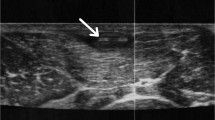Summary
Dirofilariosis is a vector-borne disease that is spreading in Europe from the southern endemic regions to the northern countries, including Slovakia. The dog parasites Dirofilaria immitis and D. repens are zoonotic agents, responsible for the development of human pulmonary and subcutaneous dirofilariosis, respectively. The present paper reports the third case of human dirofilariosis in Slovakia caused by D. repens. The pacient, a 41-year-old woman, was referred with tumour process in the subcutaneous area of the right forearm. Within 14 days the USG confirmed the rapid increase of the nodule from 20 × 10 mm to 30 × 25 mm. The surgical extirpation of the tumour was indicated. Histological examination revealed the formation with eosinofilic rime and the presence of a worm in the centre, detected as D. repens.
Similar content being viewed by others
References
Bábal, P., Kobzová, D., Novák, I., Dubinský, P., Jalili, N. (2008): First case of cutaneous human dirofilariosis in Slovak Republic. Bratisl. Med. J., 109: 486–488
Espinóza, E., Cordero, M., Muro, A., Lorente, F., Simón F. (1993): Anti-Dirofilaria immitis IgE: seroepidemiology and seasonal-variation in an exposed humanpopulation. Trop. Med. Parasitol., 44: 172–176
Fernando, S. D., Ihalamulla, R. L., De Silva, W. A. (2000): Male and female filarial worms Dirofilaria (Nochtiella) repens recovered from the scrotum. Ceylon Med. J., 45: 131–132
Genchi, C., Rinaldi, L., Mortarino, M., Genchi, M., Cringoli, G. (2009): Climate and Dirofilaria infection in Europe. Vet. Parasitol., 163: 286–292
González-Miguel, J., Rosario, L., Rota-Nodari, E., Morchón, R., Simón, F. (2010): Identification of immunoreactive proteins of Dirofilaria immitis and D. repens recognized by sera from patients with pulmonary and subcutaneous dirofilariosis. Parasitol. Int., 59: 248–256
Harrus, S., Baneth, G. (2005): Drivers for the emergence and re-emergence of vector-borne protozoal and bacterial diseases. Int. J. Parasitol., 35: 1309–1318
Kramer, L. H., Kartashev, V. V., Grandi, G., Morchon, R., Nagornii, S. A., Karanis, P., Simón, F. (2007): Human subcutaneous dirofilariasis, Russia. Emerg. Infect. Dis., 13: 150–152
MacDougal, L. T., Magoon, C. C., Fritsche, T. R. (1992): Dirofilaria repens manifesting as a breast nodule — diagnostic problems and epidemiologic considerations. Am. J. Clin. Pathol., 97: 625–630
Medlock, J. M., Barrass, I., Kerrod, E., Taylor, M.A., Leach, S. (2007): Analysis of climatic predictions for extrinsic incubation of Dirofilaria in the United Kingdom. Vector-Borne Zoonot., 7: 4–14
Miterpáková, M., Antolová, D., Hurníková, Z., Dubinský, P. (2008): Dirofilariosis in Slovakia — a new ende mic area in Central Europe. Helminthologia, 45: 20–23
Miterpáková, M., Antolová, D., Hurníková, Z., Dubinský, P., Pavlačka, A., Németh, J. (2010): Dirofilaria infections in working dogs in Slovakia. J. Helminthol., 84: 173–176
Muro, A., Genchi, C., Cordero, M., Simón, F. (1999): Human dirofilariasis in the European union. Parasitol. Today, 15: 386–389
Oleaga, A., Peréz-Sanchéz, R., Pages, E., Marcosatxutegi, C., Simón, F. (2009): Identification of immunoreactive proteins from the dog heartworm (Dirofilaria immitis) differentially recognized by the sera from dogs with patent or occult infections. Mol. Biochem. Parasit., 166: 134–141
Ondriska, F., Lengyel, D., Miterpáková, M., Lengyelová, B., Strehárová, A., Dubinský, P. (2010): Human dirofilariosis in the Slovak republic — a case report. Ann. Agr. Env. Med., 17: 169–171
Pampiglione, S., Rivasi, F. (2007): Human dirofilariasis due to Dirofilaria (Nochtiella) repens: an update of world literature from 1995 to 2000. In Genchi, C., Ronaldi, L., Cringoli, G., (Eds.): Dirofilaria immitis and D. repens in dog and cat and human infections. Italia Rolando Editore; 2007, pp. 81–116
Pampiglione, S., Rivasi, F., Gustinelli, A. (2009): Dirofilarial human cases in the Old World, attributed to Dirofilaria immitis: a critical analysis. Histopathology, 54: 192–204
Simón, F., Morchon, R., González-Miguel, J., Marcos-Atxutegi, C., Siles-Lucas, M. (2009): What is new about animal and human dirofilariosis? Trends Parasitol., 25: 404–409
Svobodová, V., Svobodová, Z., Beladičová, V., Valentová, D. (2005): First cases of canine dirofilariosis in Slovakia: a case report. Vet. Med. - Czech., 50: 510–512
Szénási, Z., Kovács, A. H., Pampiglione, S., Fioravanti, M. L., Kucsera, I., Tánczos, B., Tiszlavicz, L. (2008): Human dirofilariosis in Hungary: an emerging zoonosis in central Europe. Wien. Klin. Wochenschr., 120: 96–102
Author information
Authors and Affiliations
Corresponding author
About this article
Cite this article
Nováková, E., Kinčeková, J., Adamicová, K. et al. Human dirofilariosis: The report of subcutaneous Dirofilaria repens infection in the Slovak Republic. Helminthologia 48, 13–16 (2011). https://doi.org/10.2478/s11687-011-0003-9
Received:
Accepted:
Published:
Issue Date:
DOI: https://doi.org/10.2478/s11687-011-0003-9




